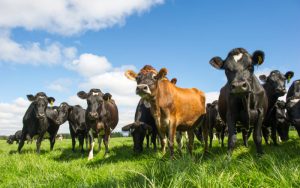
Next spring is delivery date for new tools that could eventually cut cow methane by almost a third.
Dutch dairy farmers will from next spring have access to the first of possibly two new tools that could potentially reduce methane emissions from cows by around 30%.
Next breeding season they can access semen from low methane emitting bulls, the result of an eight-year programme run by Wageningen University & Research in the Netherlands.
For the past four years researchers have collaborated with Dutch dairy company FrieslandCampina and genetics company CRV to establish breeding values for methane.
This measure alone is estimated to reduce average emissions by 1% each year, accumulating to more than 25% by 2050.
University scientists are also working on a project to utilise rumen fluid from cows that are naturally low enteric methane producers.
This rumen fluid is fed as a probiotic to newborn calves in a five-dose course.
It has been found to permanently adjust the recipient’s microbiome, providing a further 10% reduction in methane emissions.
Scientists are by nature conservative, but the team at Wageningen are encouraged their work could make a tangible reduction in livestock methane emissions.
“I am quite optimistic,” said senior researcher Léon Šebek.
“It is quite difficult, if not impossible, to reach methane reduction goals that have been pledged without any interventions other than feeding strategies.
“It shows the need for extra interventions.
“What we have shown here is that additional interventions through breeding values and steering microbiome will become available.
“If so, most Dutch dairy farms will have a suitable intervention meaning that we can achieve an average reduction of around 30% in methane by 2050.
“If we only used feed strategies and relied on the efficiency of the herd, we will only get a 15-20% reduction.”
Significantly, these one-off interventions provide permanent gains.
The project team, led by Professor Roel Veerkamp, focused on breeding values in Holsteins, which make up 92% of the 1.6 million-cow Dutch dairy population.
They measured emissions from 9000 cows on 100 Dutch farms and linked their methane emissions to their DNA, which confirmed heritability of the trait of around 25%.
Correlations with other desired breeding values were found to be maintained.
From this reference population they were able to estimate the first genomic breeding values for methane emissions, which will be rolled out next year.
The project will be extended and international collaboration will enable the reference population to be enlarged to increase the reliability of the breeding values.
This is at least a year ahead of New Zealand, where LIC expects to have a methane-emitting breeding value in the market by 2026.

In parallel to the genetics research, work has been underway since 2017 looking at the whether the natural development of a cow’s rumen microbiome can be manipulated to reduce enteric methane production.
Šebek said initial work established that while feed and feed efficiency are influential factors in emissions, there was still a 20-24% variation between cows when feed was accounted for.
This indicated other factors were in play.
For two years they worked with dairy farmers studying gut microbiome fluid samples, which related back to feeding and management.
From that analysis they established the role of the microbiome.
Šebek said they also established there was no link between the microbiome of a cow and her calf – in other words the environmental factors were dominant over possible genetic transfer.
They introduced to calves microbiome from low enteric methane producing cows and found five doses sufficient to permanently alter the production of methane in the gut of recipient calves.
To prove their encouraging hypothesis, they analysed 60 calves – 20 given microbiome from low methane producing cows, 20 from high producing cows and 20 as a control.
The average methane emissions of the selected microbiome donor groups was 17.2 and 24 grams methane/kg/DM for low and high methane producing cows respectively.
Satisfied the process will provide tangible benefits, Šebek said work is now focused on how to source the targeted microbiome and how and in what format to deliver it.
There is also the issue of securing public support or a social licence given the nature of the product.
Adopting the technology also has to be cost effective and provide sufficient benefits or incentives for farmers.
Programme manager Elian Verscheijden said recent meetings with some of the Netherlands’ most progressive dairy farmers who have used mainly feed and management measurements, showed they were able to achieve methane reductions of 10-15% but could not improve beyond that.
She said this research sends a message to the Netherlands government and the public that the sector is taking the issue seriously and it is making progress.
Both research initiatives are part of an integrated approach programme launched in 2018 to address methane emissions from livestock farming.
The program is funded by the Netherlands’ Ministry for Agriculture, Fisheries, Food Security and Nature with a budget of least NZ$16 million a year.
Besides research to enteric methane, the programme also includes finding solutions to reduce methane emissions from manure, a significant issue for Dutch farmers.
The first goal of the programme is to comply with the government’s 2030 goal to reduce methane by 30% compared to 2020.
Ultimately the government has a goal of close to carbon neutrality by 2050.
More: Wallace is visiting seven countries in six weeks to report on market sentiment, a trip made possible with grants from Fonterra, Silver Fern Farms, Alliance, Beef + Lamb NZ, NZ Meat Industry Association and Rabobank. Read more about his findings here.
You can now read the most important #news on #eDairyNews #Whatsapp channels!!!
🇺🇸 eDairy News INGLÊS: https://whatsapp.com/channel/0029VaKsjzGDTkJyIN6hcP1K




















